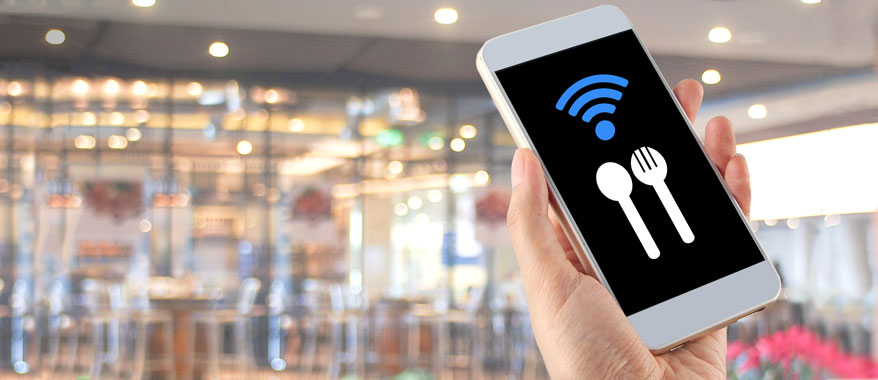Although technology is a key tool for business innovation, the restaurant industry has long been reluctant to embrace it. Times seem to be finally changing.
Tech magazine Hospitality Technology has been tracking technology investments in restaurants for the past 18 years. For the 2016 Restaurant Technology Study, they surveyed over 32,000 quick service, casual and fine dining restaurants in the United States to identify restaurateurs’ current and future technology investments. The survey’s findings show that the industry is moving – however slowly.
Are you a restaurateur with a good plan and the will to innovate?
Now is your chance to create an establishment that is more relevant to modern customers – and perhaps more popular, too. Here are the key trends we identified from the survey’s findings, and which you can leverage to get a competitive advantage over the average restaurant:
1. IT budgets: increasing, but badly allocated
In 2015, the average IT budget for restaurateurs was 2,5% of revenue. IT budgets have been increasing every year for the last four years, after the budget cuts in 2009 and 2010 and a static period in 2011-12. Fitting in the recent trend, budgets will rise again, although slowly, in 2016.
The problem for many restaurants this year is not insufficient budget but bad allocation of funds. Most restaurateurs wish they could invest more in R&D and innovation projects, but their funds are heavily tied in costly system maintenance. On average, surveyed restaurants spend a whopping 60% of their IT budget to maintain current systems. For two out of five respondents, legacy systems are a real burden and make them unable to jump into new technology projects.
A word of advice: If most of your IT expenditure is tied down in system maintenance, it may be time for an upgrade – or a new system. This year, half of the surveyed restaurants will change their POS system, and 40% have planned changes to their back office system, too.
2. It’s all about the software
Software expenditure has been steadily increasing in the restaurant industry, and this year it dominates the IT spending. In 2015, restaurants dedicated 32% of their IT budgets to software, up from just 20% in 2012.
In 2016, most of the spending will concentrate on increasing customer engagement, improving mobilityand implementing cloud-based software.
- By implementing tech aimed at improving guest engagement, such as loyalty apps and CRM, restaurateurs are hoping to stay relevant with modern consumers. Operators are trying to deepen engagement and connect with customers across the experience continuum, not just in the restaurant.
- Today, the customer journey is very different from what it was just a few years ago: people research and review options from home, and can even choose, order and eat without ever leaving the couch. Restaurateurs are slowly adapting to the changed times, and this year they will be focusing on implementing digital solutions – from mobile payments to digital ordering – directed at making dining convenient and frictionless for the modern customer.
- Cloud-based software is the top priority on this year’s R&D list of projects. Restaurateurs count on the cloud, with its subscription-based pricing, as the solution that will rid them of the high system maintenance costs that are bogging them down.
A word of advice: The more solutions you implement, the more integration issues. To minimize them, choose an end-to-end system like LS Hospitality, which covers from POS to warehousing to accounting and includes mobility and loyalty – all in one. With LS Hospitality, restaurateurs can also reach out to mobile customers creating campaigns and coupons and publishing them on social media straight from the back office. And to avoid costly mistakes when selecting a software solution, download our free white paper: “7 Food Service Management Software Selection Mistakes that Spell Failure“.
3. Leaders have different priorities
In the survey, respondents are divided into three groups: leading the way are restaurant innovators (circa one third of participants), who spend and achieve more than competitors when it comes to innovation; coming last are the laggards, less innovative than the average, and achieving lower ROI and results from their tech.
The survey results show that the two groups have very different priorities. Restaurant innovators are more likely than the average to start IT projects to support innovative, revenue-generating business models. They are also more likely to have a CIO who oversees and drives innovation.
On the other side of the spectrum, laggards are mostly investing in tech that insures high degree of security and compliance. For these followers, the biggest challenge this year will be lack of sufficient budget; for innovators, who are introducing many new business-driven tech solutions into their operations, this year’s top challenge will instead be system integration.
A word of advice: Whichever your situation, do not deploy more technology without a well-designed plan, in a game of “follow the leaders”. If you have a clear tech strategy in place, you can insure that your investments bring ROI and drive innovation.
4. Taking it one step at a time
Even though investments in IT are increasing, restaurateurs still seem to be thinking no further than tomorrow. Analytics will be a crucial tool to help restaurateurs understand the data created by their new mobile solutions. Yet, for the moment only 22% of operators plan to invest in data analysis. Analytics suites will probably grow in demand in the near future, as operators will need them to wade through the complexity more and more data will bring; but this is, apparently, not yet a priority.
The top challenge for restaurant IT squads still appears to be justifying ROI: two out of five respondents say that they have a hard time rationalizing buying new tech. This is, however, a bigger problem for laggards than for innovators – probably because many more companies in the group of innovators have a CIO, and therefore a longer-term vision of tech’s gains versus costs.
A word of advice: Analytics is the key to personalization and engagement, yet few restaurants have data analysis projects on their plate. Customer insights through business intelligence and reporting will undoubtedly be key for success in the near future. To stay ahead of the wave, make sure you have the in-house competencies necessary to understand and implement these projects.
5. More disruption in the future
Although the restaurant industry is making steady progress, levels of technology adoption are still relatively slow. Interestingly, many of the tech buzzwords of the moment won’t be a focus this year, at least among the surveyed operators. From 3D food printing, to augmented reality, to beacons and IOT, few operators seem ready to – or interested in – becoming a next-gen restaurant.
Even data and analytics have had a limited spread so far in the industry; if restaurateurs want to stay relevant and top of mind, they will however need to jump on the data analytics train.
As customer engagement becomes more and more important, restaurateurs will need to focus on offering tools that fit in with the customer journey. From effective apps (one third of restaurateurs surveyed still don’t offer one!) to mobile payments to tableside ordering and social media interactions, the keyword for the future is frictionless service – in and out of the restaurant.
Article written by Giada Pezzini
http://www.lsretail.com/blog/restaurant-technology-trends-great-opportunities-innovators/

